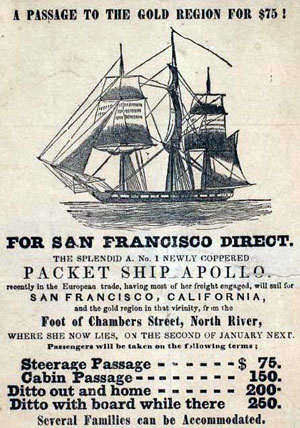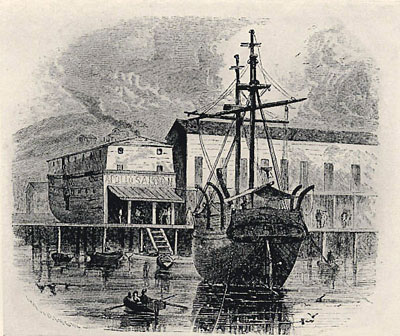National Register of Historic Places in San Francisco
Apollo Storeship
Sacramento and Battery Streets
The remains of the packet ship Apollo lie buried beneath the old Federal Reserve Bank of San Francisco.
Apollo was modified for use as a storeship in January of 1850. In imitation of the storeship Niantic two blocks away, she was beached on the mudflats of the San Francisco waterfront. (Niantic was excavated and partially removed in 1978. Apollo has never been excavated.)
Apollo lay between Central Wharf and Howison's Pier, parallel to the wharves, with her bow facing inland. Her ballast was removed, her masts pulled, and a two story frame "barn" was erected to completely house over her decks.
The barn was subdivided into stores and offices. Large doors were cut into the side of the hull and the interior was used as a warehouse. A stage, or wharf, built on the starboard side of the beached hulk, was connected to Central Wharf.
A small frame structure was built at the ship's stern facing Battery street. This housed the Apollo Saloon, a popular doughnut and coffee house. The Apollo Storeship and the "saloon" remained in business until destroyed by fire on May 4, 1851.
The fire burned Apollo to a point just below the waterline at the turn of her bilge. Her cargo of unburned merchandise and a variety of burnt materials fell into her hull and into the mud and water. (Niantic, which burned in the same fire, was similarly preserved in mud.) After the fire, Apollo's burned hulk was covered by clean sand, and new structures were built atop the landfill.
The remains of Apollo, entombed in mud and sand along Sacramento street, were periodically uncovered in the 20th century as construction removed some of the fill that covered the ship's bones.
In 1901, excavations for an elevator shaft encountered a portion of the hull. The construction of the Federal Reserve Bank of San Francisco exposed nearly the entire interior of the ship as well as the tops of the charred pilings of the wharves which linked Apollo to the shore.
The last exposure of any portion of the ship was in 1925, when excavations at the rear of the bank, on the corner of Sacramento and Battery streets, exposed the stern and rudder as well as several Gold Rush artifacts.
Adapted from the NRHP nomination form

